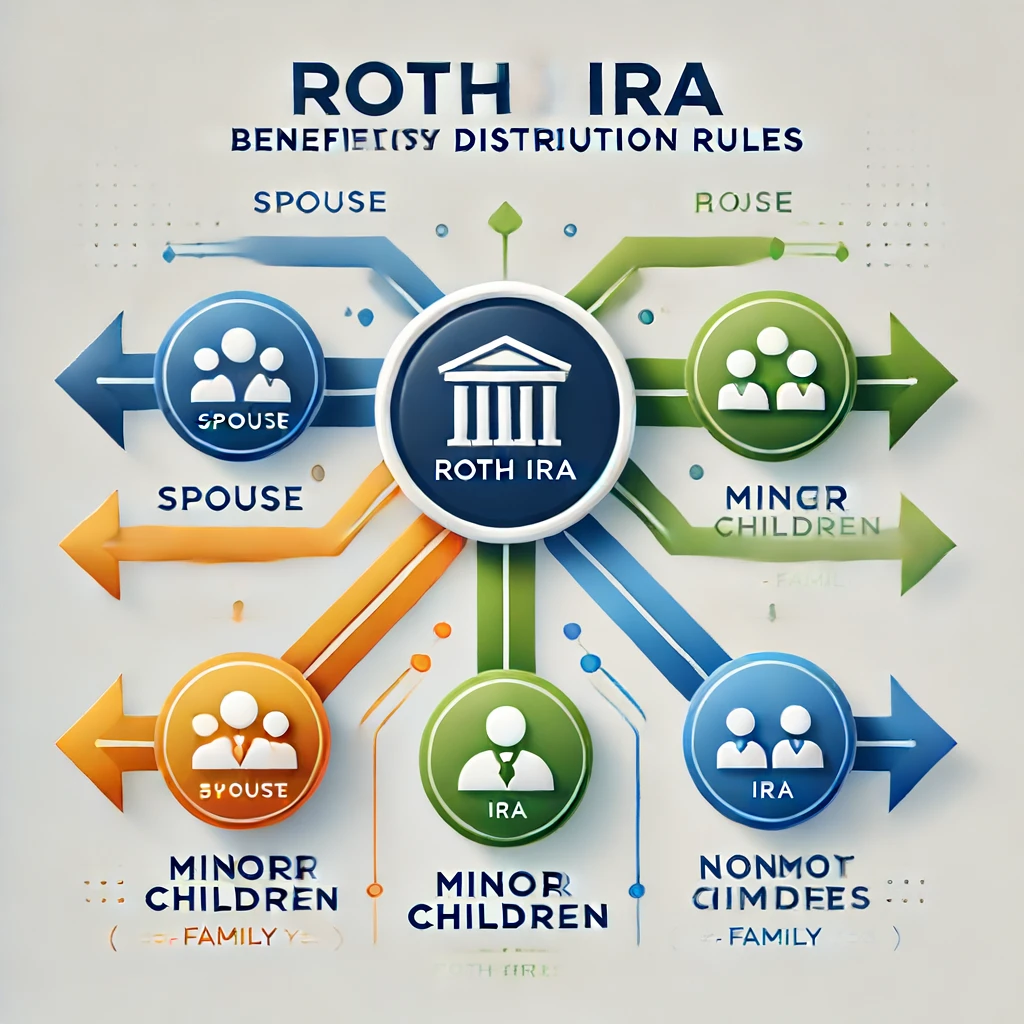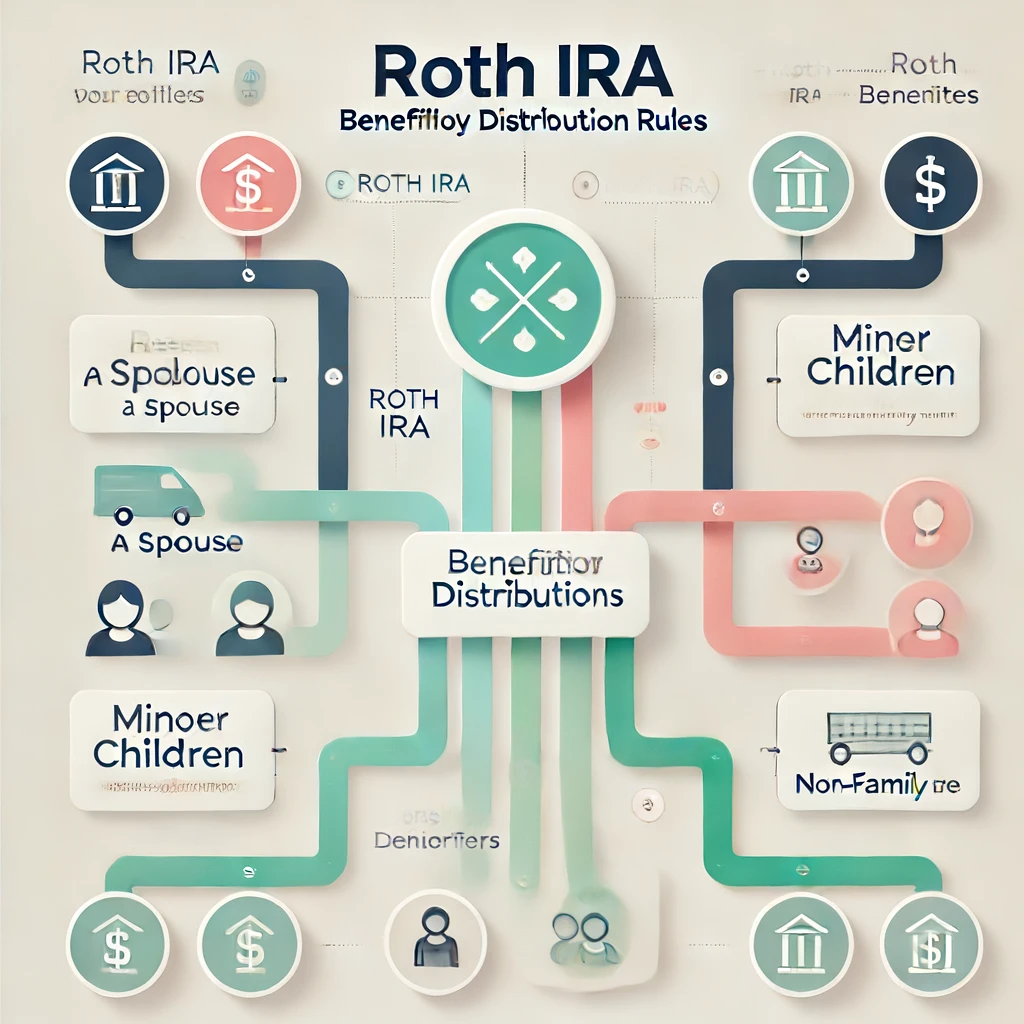What Happens to Your Roth IRA When You Die?
When you pass away, your Roth IRA doesn’t just disappear. Instead, it becomes a legacy for your beneficiaries. The Roth IRA beneficiary distribution rules determine how these funds are distributed. Unlike traditional IRAs, Roth IRAs have specific advantages that can significantly benefit your heirs.
Key Players: Eligible and Non-Eligible Designated Beneficiaries
Before diving into the rules, it’s essential to differentiate between Eligible Designated Beneficiaries (EDBs) and Non-Eligible Designated Beneficiaries (NEDBs). This classification impacts how the distribution rules apply:
- Eligible Designated Beneficiaries: This group includes your spouse, minor children, disabled or chronically ill individuals, and those who are not more than 10 years younger than you. They have more flexible distribution options.
- Non-Eligible Designated Beneficiaries: These are typically adult children, friends, or other relatives. They follow stricter distribution timelines.
Spousal Beneficiaries: Flexibility and Choices
If your spouse is the beneficiary of your Roth IRA, they have several options under the Roth IRA beneficiary distribution rules:
- Treat as Their Own: They can transfer the account into their own Roth IRA, continuing to grow the funds tax-free.
- Inherited IRA: Alternatively, they can treat it as an Inherited IRA, which allows them to take distributions based on their life expectancy.
Choosing the right option depends on their financial situation and needs.
Non-Spousal Beneficiaries: The 10-Year Rule
For non-spousal beneficiaries, the Roth IRA beneficiary distribution rules introduce the 10-Year Rule. This rule mandates that all funds from the inherited Roth IRA must be distributed within ten years of the original owner’s death. Unlike traditional IRAs, there are no Required Minimum Distributions (RMDs) for Roth IRAs during this period, giving beneficiaries some flexibility. They can choose to:
- Take distributions as they see fit within the 10 years.
- Let the funds grow tax-free and withdraw everything by the end of the 10 years.

Minor Children: Reaching the Age of Majority
For minor children named as beneficiaries, the rules are slightly different. The Roth IRA beneficiary distribution rules allow for distributions based on their life expectancy until they reach the age of majority. Afterward, the 10-Year Rule kicks in, requiring the remaining funds to be distributed within ten years.
Disabled or Chronically Ill Beneficiaries
Disabled or chronically ill beneficiaries also receive favorable treatment under the Roth IRA beneficiary distribution rules. They can take distributions based on their life expectancy, providing a steady income stream. This provision ensures they are not forced to deplete the account quickly, which could be detrimental to their long-term financial health.
Tax Implications for Beneficiaries
One of the most significant advantages of a Roth IRA is that qualified distributions are tax-free. This benefit extends to beneficiaries as well. Here’s how the tax rules play out under different scenarios:
- Qualified Distributions: If the Roth IRA has been open for at least five years, beneficiaries can withdraw funds tax-free.
- Non-Qualified Distributions: If the account hasn’t met the five-year holding period, earnings withdrawn might be subject to taxes but not penalties.
Understanding these tax rules helps beneficiaries plan their distributions strategically, maximizing the benefits.
Navigating the Process: Steps for Beneficiaries
Step 1: Identifying Your Beneficiary Status
First, beneficiaries need to determine their status: Are they an EDB or NEDB? This classification affects their options and obligations.
Step 2: Choose the Right Distribution Option
Depending on your status, choose the distribution method that best fits your financial needs. For spouses, deciding whether to treat the Roth IRA as their own or as an inherited IRA is crucial. Non-spouses need to plan their withdrawals carefully within the 10-year window to optimize tax advantages.
Step 3: Consider the Tax Implications
Beneficiaries should consult with a financial advisor to understand the tax implications of their withdrawals. This step is significant if the account hasn’t reached the five-year mark.
Strategies for Maximizing Inherited Roth IRA Benefits
To fully leverage the benefits of an inherited Roth IRA, consider these strategies:
For Spouses
- Treating the IRA as Their Own: This option is generally the best if the surviving spouse doesn’t need immediate access to the funds. It allows for continued tax-free growth and no RMDs.
- Inherited IRA: If the spouse needs access to the funds sooner, this can be a better option, providing flexibility in distribution.
For Non-Spouses
- Delay Withdrawals: Beneficiaries can let the Roth IRA grow tax-free for up to 10 years. This strategy is beneficial if they don’t need the funds immediately and want to maximize growth.
- Strategic Withdrawals: Spread withdrawals over several years to manage tax implications effectively, especially if the account hasn’t met the five-year rule.
For Minor Children
- Life Expectancy Distributions: Use this option while they are minors to provide a steady income.
- Prepare for the 10-Year Rule: Plan for larger withdrawals once the child reaches the age of majority.
For Disabled or Chronically Ill Beneficiaries
- Life Expectancy Distributions: Leverage this benefit to ensure a stable financial future.
Common Pitfalls and How to Avoid Them
Even with the best planning, mistakes can happen. Here are some common pitfalls regarding Roth IRA beneficiary distribution rules and how to avoid them:
- Not Updating Beneficiary Designations: Ensure your beneficiary information is current to avoid unintended distributions.
- Misunderstanding the 10-Year Rule: Non-spousal beneficiaries should plan their distributions carefully within the 10 years to avoid tax penalties.
- Ignoring the Five-Year Rule: Be aware of the account’s age to understand if distributions will be taxed as non-qualified.
Conclusion
Understanding the Roth IRA beneficiary distribution rules is essential for effective estate planning. Whether you’re a spouse, child, or non-family member, knowing your options and obligations ensures you make the most of your inherited Roth IRA. By planning strategically and consulting with a financial advisor, you can maximize the benefits and avoid common pitfalls.
For more detailed advice tailored to your specific situation, consider reaching out to a financial expert at Carmichael Hill & Associates. We’re here to help you navigate these complexities and make informed decisions about your financial future.

